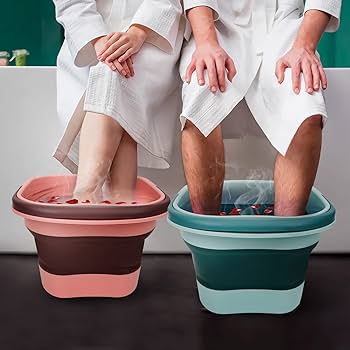 I thought it might be helpful – albeit a bit disgusting – to talk about one of the ickier (that’s a medical term) thing that you run across from time to time in a horse: an abscess. I’ve seen them in several spots on horses over the years, and, while all abscesses are pretty much the same thing, they can certainly cause different sorts of problems, depending on where they turn up.
I thought it might be helpful – albeit a bit disgusting – to talk about one of the ickier (that’s a medical term) thing that you run across from time to time in a horse: an abscess. I’ve seen them in several spots on horses over the years, and, while all abscesses are pretty much the same thing, they can certainly cause different sorts of problems, depending on where they turn up.
First, let’s define what an abscess is. Quite simply, an abscess is an accumulation of pus. Yuck.
“What’s pus?” you might rightly ask, perhaps for the first time in your life. Pus is a rather disgusting liquid that’s made up of dead white blood cells (the cells that fight infections), bacteria (sometimes, but not always), tissue debris, and blood serum (serum is the liquid that the blood cells float around in). Seriously: that’s it.
WHAT CAUSES AN ABSCESS?
For an abscesses to occur, several things have to happen:
 Something enters some point on the horse’s body and causes inflammation and/or infection
Something enters some point on the horse’s body and causes inflammation and/or infection- The horse’s body sends infection-fighting cells (white blood cells, or WBC, for the sake of brevity) to the affected area
- The WBC’s attack somewhat indiscriminately, killing not only bacteria (if there are bacteria there) but also surrounding tissue, some of which also dies. The WBC get destroyed in the process, as well (they’re somewhat suicidal in their approach to attacking inflammation and/or infection).
- This biological war zone creates a hole, which fills with the accumulated debris (pus).
HOW DO YOU TREAT AN ABSCESS?
 The principles of treating an abscess, are, honestly, quite simple. They have to be opened and drained. This is usually a job reserved for your veterinarian (although sometimes horses just do it on their own). Depending on the location and the size, opening an abscess can be one of the messier and more disgusting parts of the job, but I digress. Unfortunately, in the most difficult cases, the abscess can’t be opened and drained, and this can cause real problems for the horse.
The principles of treating an abscess, are, honestly, quite simple. They have to be opened and drained. This is usually a job reserved for your veterinarian (although sometimes horses just do it on their own). Depending on the location and the size, opening an abscess can be one of the messier and more disgusting parts of the job, but I digress. Unfortunately, in the most difficult cases, the abscess can’t be opened and drained, and this can cause real problems for the horse.
Antibiotics are also sometimes given to treat abscesses, ideally after the abscess is opened and drained. However, there are a lot of different things to consider when treating an abscess with antibiotics, usually depending on where the abscess is. We’ll get into that.
Unfortunately, on their own, antibiotics may not be able to cure an abscess. That’s because in the middle of an abscess there’s just a bunch of liquid. There’s no blood circulation to get the antibiotics in. We’ll talk more about that, too.
Anyway, with that introduction, let’s talk about a few specific circumstances where you might see an abscess in your horse, and what you can do about them.
HOOF ABSCESSES
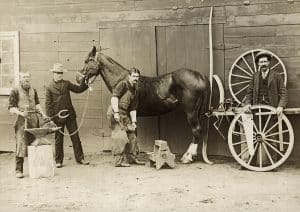 Hoof abscesses are one of the most annoying and alarming causes of lameness in the horse. Fortunately, as annoying as they are, they tend to resolve pretty quickly once you find out where they are. They’re alarming because horses with hoof abscesses are generally extremely lame; they’re reluctant to put their foot down on the ground because it hurts. If you haven’t seen one before, you might even think the horse has broken his leg (I’ve had that call several times).
Hoof abscesses are one of the most annoying and alarming causes of lameness in the horse. Fortunately, as annoying as they are, they tend to resolve pretty quickly once you find out where they are. They’re alarming because horses with hoof abscesses are generally extremely lame; they’re reluctant to put their foot down on the ground because it hurts. If you haven’t seen one before, you might even think the horse has broken his leg (I’ve had that call several times).
If you follow the formula for how abscesses occur, #1 is that there’s usually some break in the foot, either due to trauma, or because something is put into the foot (like a horseshoe nail). In wet weather, or on muddy ground, when the soles get soft, a small split might occur, introducing bacteria. If a nail gets placed too close to sensitive tissue, bacteria gets introduced, and an abscess can form.
The key to treating an abscess of the hoof is, 1) finding it (usually with a hoof testers) and, 2) opening it (usually with a hoof knife). After that, people usually go about soaking the hoof, under the premise of rinsing out the gook, and then packing it in some sort of an antiseptic or disinfectant ointment.
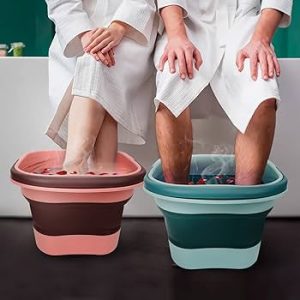 NOTE #1: When it comes to soaking and packing, it sure does seem important, but I always remember back to a mare that I looked at when I was a junior veterinary student, who was a member of the broodmare herd at the Repro Center at Colorado State University. She came hobbling in out of pasture and it was pretty obvious her foot hurt. I opened up the abscess and she ran back out to pasture and recovered quickly. There were no facilities to hold her to soak that foot and a foot bandage would have lasted a nanosecond or two in the hard pasture. Plus, she was hard to handle, anyway. The bottom line is that, by all means, soak and pack the foot for a few days – it’s just after that experience, I’m not always sure how important it is.
NOTE #1: When it comes to soaking and packing, it sure does seem important, but I always remember back to a mare that I looked at when I was a junior veterinary student, who was a member of the broodmare herd at the Repro Center at Colorado State University. She came hobbling in out of pasture and it was pretty obvious her foot hurt. I opened up the abscess and she ran back out to pasture and recovered quickly. There were no facilities to hold her to soak that foot and a foot bandage would have lasted a nanosecond or two in the hard pasture. Plus, she was hard to handle, anyway. The bottom line is that, by all means, soak and pack the foot for a few days – it’s just after that experience, I’m not always sure how important it is.
NOTE #2: If your horse would rather try to kill you than try to stand with its foot in a bucket, don’t press it.
NOTE #3: Sometimes you suspect that there’s an abscess but you can’t find it. In such cases, people usually recommend soaking the foot, either to 1) try to soften the hoof and/or 2) to try to “draw” the abscess out. Frankly, I’m not sold on #1 and #2 is based on 17th century medical ideas that really don’t make any sense, but people will probably keep doing it anyway. It doesn’t really hurt, however, do pay attention to NOTE #2.
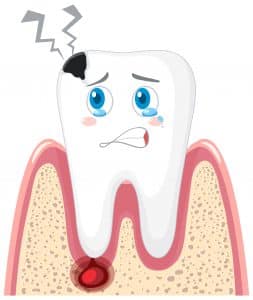 TOOTH ABSCESSES
TOOTH ABSCESSES
Tooth abscesses are mostly a problem in older horses. As horse age, their teeth keep getting pushed out until there is very little root left. The old root can get infected and an abscess can form. The most common clinical sign of an abscess of an upper tooth root is a really nasty smell (of anaerobic bacteria) coming out of a nostril: usually the one on the same side as the tooth. The reason for the smell is that the tooth root goes up into the sinus – an air cavity inside the skull – and the sinus gets infected, too. So, while the treatment is to remove the tooth, to get rid of the infection, affected horses can also get a sinus infection that has to be dealt with. When lower tooth roots abscess, it usually causes as hard, sore swelling in the jaw. These are much less common, but the treatment is the same; pull the tooth. There’s a good bit of aftercare with these, as well.
POST-VACCINATION (POST-INJECTION)
 A rarely seen, but super-annoying, abscess problem can occur after vaccination, or after any kind of shot in the muscle, really. There are actually two types of abscesses that can occur after a shot: infectious and non-infectious (so called, “sterile” abscesses). In the case of post-vaccination abscesses, the “something” that enters the horse’s body is a vaccine. Very occasionally (much less commonly that you might think, actually), sticking a needle into the horse introduces an infection, which causes an abscess. The other thing that can happen is that the mere process of vaccination causes enough inflammation to cause an abscess, even though there’s no infection. I know that there are plenty of stories of vaccine reactions, but, overall, the good of protecting horses outweighs the bad of the occasional reaction in an individual horse. The treatment is as you might expect; as soon as an abscess is recognized, it should be opened and drained to the outside.
A rarely seen, but super-annoying, abscess problem can occur after vaccination, or after any kind of shot in the muscle, really. There are actually two types of abscesses that can occur after a shot: infectious and non-infectious (so called, “sterile” abscesses). In the case of post-vaccination abscesses, the “something” that enters the horse’s body is a vaccine. Very occasionally (much less commonly that you might think, actually), sticking a needle into the horse introduces an infection, which causes an abscess. The other thing that can happen is that the mere process of vaccination causes enough inflammation to cause an abscess, even though there’s no infection. I know that there are plenty of stories of vaccine reactions, but, overall, the good of protecting horses outweighs the bad of the occasional reaction in an individual horse. The treatment is as you might expect; as soon as an abscess is recognized, it should be opened and drained to the outside.
NOTE: If your horse has bad reactions to injections in the muscle, it’s probably smart to not keep injecting him in the muscle, or at least do it as infrequently as possible. There are other routes of administration for many products (e.g., oral, intra-nasal). This is something to talk to your veterinarian about.
CORNEAL ABSCESSES
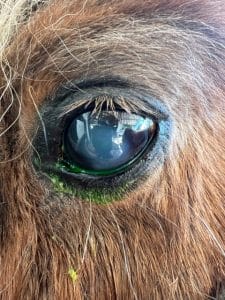 I’ve seen a few abscesses that occur in the cornea: the clear covering of the eye. They don’t happen very often but they can be a real pain to treat. They usually show up after a horse scratches its eye. The scratch (ulcer) gets infected: sometimes in spite of treatment. See step #1. These are generally extremely painful for the horse.
I’ve seen a few abscesses that occur in the cornea: the clear covering of the eye. They don’t happen very often but they can be a real pain to treat. They usually show up after a horse scratches its eye. The scratch (ulcer) gets infected: sometimes in spite of treatment. See step #1. These are generally extremely painful for the horse.
One big problem with a corneal abscess, of course, is that you can’t open and drain it. Ideally, you’d like to have the horse end up with an eye that can see after it’s all over and cutting a big chunk out of the cornea isn’t the best way to achieve that goal. Fortunately, the cornea is pretty thin, so it’s often amenable to antibiotic treatment. As such, you have to treat the horse’s eye constantly with an antibiotic that has been shown to be effective at killing whichever bug is causing the abscess. It’s all rather involved and certainly something that should be supervised by your veterinarian. Treatment can take weeks.
INTERNAL ABSCESSES
 The worst sort of an abscess is one that occurs inside the horse’s body. Probably the most common cause of abscesses inside the horse’s body is after he gets an infection with Strep equi – you may know it as “Strangles.”
The worst sort of an abscess is one that occurs inside the horse’s body. Probably the most common cause of abscesses inside the horse’s body is after he gets an infection with Strep equi – you may know it as “Strangles.”
I’ve written an article about strangles that might be worth reviewing (CLICK HERE). For some reason, in a few horses, the infection spreads from the lymph nodes under the throat, to other places. Among the most troubling of the places are the lymph nodes inside the horse’s abdomen. Here in the worst case scenario, the infection can rage unchecked: sometimes until it’s too late.
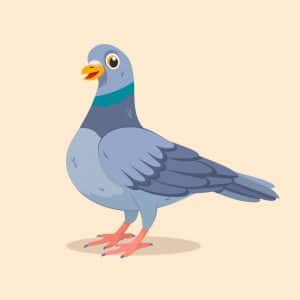 One insurmountable problem with internal abscesses is that the main principle of treating abscesses – open and drain – isn’t available. You can’t go on an abdominal fishing expedition. So, you have to rely on antibiotics, and that’s an iffy proposition, for reasons I already stated.
One insurmountable problem with internal abscesses is that the main principle of treating abscesses – open and drain – isn’t available. You can’t go on an abdominal fishing expedition. So, you have to rely on antibiotics, and that’s an iffy proposition, for reasons I already stated.
A couple of decades back, I saw a horse who was acting weird. He’d get unexpectedly frantic, then seem calm, then act wild again. He had internal abscesses: in his brain. Sadly, that one didn’t turn out well.
One other infection that causes abscesses deserves mention, even though it’s distribution is pretty local, mostly showing up in the western US. That’s called “Pigeon Fever” by most (no offense to pigeons) because horses get abscesses in their chest that make them swell up in the chest like a pigeon. I won’t get into treatment of the disease, but the American Association of Equine Practitioners wrote a great article about it that you can read if you (CLICK HERE).
IN SUM
As with a lot of things in life, while abscesses are actually a fairly simple concept, they have a whole lot of variations, some of which can be quite difficult to deal with. Even so, if you understand the principles of handling them (identify, open, drain – maybe antibiotics), most of them will resolve without too much trouble (NOTE: I said “most”). A lot of mess, to be sure, but, fortunately, not too much trouble.

